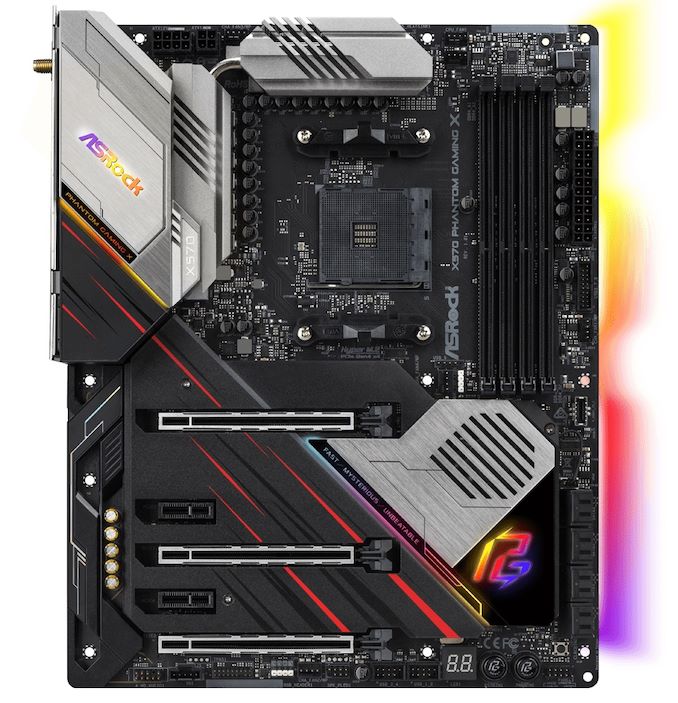The AMD X570 Motherboard Overview: Over 35+ Motherboards Analyzed
by Gavin Bonshor on July 9, 2019 8:00 AM ESTASRock X570 Phantom Gaming X
Another of the most high-end options from ASRock is the X570 Phantom Gaming X. The ASRock X570 Phantom Gaming X is a red, silver, and black themed premium gaming-focused model with some notable inclusions common to the Phantom Gaming branding. The most notable inclusion is the Realtek RTL8125AG 2.5 G LAN which is aimed at arming gamers with networking options.
In between the three full-length PCIe 4.0 slots is two PCIe 4.0 x1 slots, with support for up to three-way AMD CrossFire, and two-way NVIDIA SLI multi-graphics card configurations. Memory support is also much improved for Ryzen 3000 with official support for up to DDR4-4666, with a total of four slots available for users; this model also supports up to 128 GB of system memory. ASRock's X570 Phantom Gaming X is also geared for enthusiasts with a 14-phase power delivery which uses an 8-pin, and 4-pin pairing of 12 V ATX CPU power inputs. On the rear is a steel PCB brace which adds support to the PCB, as well as extra weight. On the storage front, there are three PCIe 4.0 M.2 slots, eight SATA ports, and ASRock's U.2 kit which available separately is also supported.
On the rear panel is a single USB 3.1 G2 Type-A, one USB 3.1 G2 Type-C, and six USB 3.1 G1 Type-A ports. The onboard audio is driven by the Realtek ALC1220 HD audio codec and offers uses five 3.5 mm audio jacks, a single S/PDIF optical output, with software support for Creative's Sound Blaster Cinema 5 software The rear panel also includes a Realtek RTL8125AG 2.5 Gigabit Ethernet port with a secondary Intel Gigabit port for dual LAN. Also featured is an Intel AX200 802.11ax Wi-Fi wireless interface, a Realtek ALC1220 HD audio codec, a single HDMI 1.4 video output, a clear CMOS button and a BIOS Flashback button.
The ASRock X570 Phantom Gaming X isn't as high-end as some of the other its new models such as the X570 Aqua, or X570 Creator, but gamers will find plenty of useful features to sink their teeth into. The ASRock X570 Phantom Gaming X has an MSRP of $350 and represents its flagship gaming model; a Realtek 2.5 G NIC and an Intel AX200 Wi-Fi 6 wireless interface add extra cost, but the board does lack a lot on the USB G2 connectivity on the rear panel, which is a little disappointing given the mid-range price tag.












225 Comments
View All Comments
abufrejoval - Tuesday, July 9, 2019 - link
It's amazing how quickly you run out of PCIe lanes, when you don't have switches to multiplex and translate between PCIe revisions and lanes (e.g. PCIe v4 x2 <-> PCIe v2 x8).I find myself using USB 3.x NBase-T NICs and NVMe adapters, simply because they *do* switch.
Bensam123 - Tuesday, July 9, 2019 - link
Maybe a bit more depth on the power delivery page. I have absolutely no idea how to go about parsing what's there. More chokes is better? What denotes a power phase?A5 - Tuesday, July 9, 2019 - link
+1. Some analysis of that information would be helpful.MrSpadge - Tuesday, July 9, 2019 - link
+1bunkle - Wednesday, July 10, 2019 - link
The controller column includes the total number of phases supported split between CPU cores and SoC e.g. (6+1) = 6 CPU phase and 1 SoC phase. More is *usually* better but has diminishing returns regarding tighter and tighter voltage regulation. Some controllers are better than others (can operate at high frequency e.g. 500KHz v 1000KHz, include other features to improve performance) mitigating the need for more phases.Each phase is a buck converter comprised of a low/high side MOSFET (can be integrated in a single package) and choke. Some controllers can support doubling up the PWM signal to driver more MOSFETs. Doublers can also be added as discrete components if not built into the controller.
Current rating of the MOSFET (e.g. Sic639=40A IR3555=60A) indicates the total power deliverable. MOSFETs are not 100% efficient and vary in efficiency. The more current they provide the hotter they get and the less efficient they become, with better MOSFETs producing less heat for a given current. Thus using doubles can improve temperatures and efficiency without the benefits of the tighter voltage tolerance that *real* phases provide.
Hope that’s helpful!
bunkle - Wednesday, July 10, 2019 - link
A lot more detailed explanation: https://en.wikichip.org/wiki/voltage_regulator_mod...bug77 - Tuesday, July 9, 2019 - link
The description for AsRock X570(M) Pro4 says "5 jack + 1 SPDIF". Unfortunately, those boards lack SPDIF and only come with 3 jacks ;)Smell This - Tuesday, July 9, 2019 - link
I'm thinking the *ASRock Thunderbolt AIC* ...https://thunderbolttechnology.net/product/asrock-t...
would cover all your TBT peripheral needs, including optical.
DanNeely - Tuesday, July 9, 2019 - link
Do X570 boards still need an extra chip per USB port to support USB-C reversibility?The additional expense and needed PCB space were cited as among the reasons why earlier generation boards (IIRC both Intel and AMD) almost never had more than 1 C port; but it was never clear to me if that was an inherent implementation penalty for the C port or an artifact of Intel's tech stack being stalled out and AMD outsourcing to ASMedia which built the chipsets on an ancient (55nm) platform.
DigitalFreak - Tuesday, July 9, 2019 - link
Gavin - X370 and X470 only supported PCIe 2.0. The connection between the CPU and chipset was 3.0, but all the ports on the chipset were 2.0.